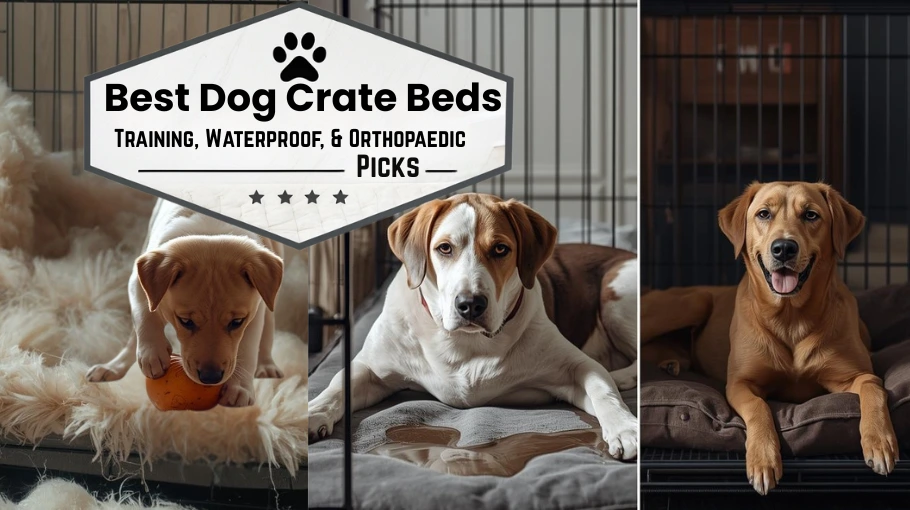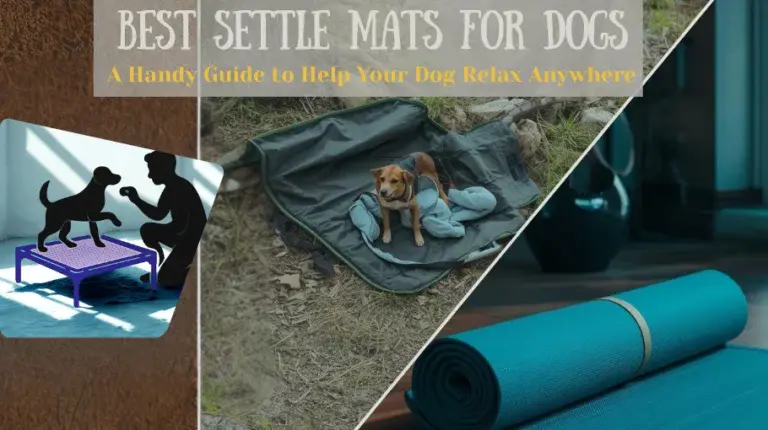3 Best Dog Crate Beds: Training, Waterproof & Orthopaedic Picks

The best dog crate beds aren’t about luxury… They’re about matching the bed to the current phase your dog’s going through. Puppies need durability, adults need waterproof comfort, and seniors need proper joint support.
Finding the best dog crate bed is trial and error, because there’s different needs for different breeds, and the phase they’re at.
When we had our late senior Staffy with joint problems and two teething pups at the same time, balancing comfort, chew-resistance, and cost felt impossible. We went through more beds than I’d like to admit before realising one thing: crate beds aren’t one-size-fits-all.
Each stage calls for something different.
- Puppyhood: chew and water-resistant materials help them learn without destroying everything in sight.
- Adulthood: waterproof beds that can handle wet walks, muddy paws, and everyday lounging.
- Senior years: orthopaedic support to ease joints and make getting up less of a struggle.
Discover the Best Dog Crate Beds for Every Phase
➢ Best Dog Bed for Crate Training: Pet Wiz Dog Crate Mat

- ✅ Ideal for puppies in the potty training or chewing phase.
- ✅ Great for crate training any dog — puppy, rescue, or otherwise.
- ✅ Suitable for anxious dogs with a tendency to gnaw on bedding.
For crate training, it’s hard to beat the practicality of the Pet Wiz Dog Crate Mat. It’s made from 600D Oxford ripstop fabric on both sides — no fluffy bolsters or rubber bases for teething pups to grab — and it’s tough enough to handle digging, pawing, and all the usual puppy chaos.
While it’s described as “waterproof,” it’s more accurate to call it water-resistant.
The Oxford fabric repels small spills and light accidents, but if liquids sit for too long, they can seep through the stitched seams. In truth, that’s not necessarily a bad thing for dogs still learning. During potty training, that mild discomfort helps them associate their crate bed as a place to keep clean, not a toilet spot.
The polyester fibre and PP filling offer a bit of cushioning without trapping moisture, and the mat’s low profile fits easily into standard wire crates. For best results, use it in a slightly larger crate with a divider — or place a cheap waterproof dog blanket on top. That keeps the mat fresh and adds an extra barrier without losing comfort.
Best for: Puppies, crate training, and early teething phases.
Pros: Durable ripstop fabric, dig-resistant, easy to wipe down.
Cons: Water-resistant, not fully waterproof; light cushioning only.
Check the latest deals on the Pet Wiz Dog Crate Mat here!
➢ Best Waterproof Dog Crate Bed: Ancol Waterproof Cushion Bed

- ✅ Fully waterproof nylon — easy to rinse clean.
- ✅ Bolstered design adds comfort and safety.
- ✅ Thick and supportive — ideal for post-walk naps.
If your dog comes in soaked after a walk or rolls in every puddle they find, a waterproof bed is more than convenience — it’s essential.
The Ancol Waterproof Cushion Bed offers the right balance of protection, comfort, and practicality. It’s made from heavy-duty nylon with a bonded waterproof membrane, not just a coated fabric, which makes it far more reliable for long-term use.
The bed’s bolstered edges add a layer of comfort that many flat mats can’t match. They give dogs a place to rest their head and also add a bit of safety — preventing paws or noses from slipping through crate bars when they shift around in their sleep.
Inside, it’s thickly padded and generously filled, while the reinforced seams and non-slip base keep it sturdy on hard floors or inside the crate.
Both the cover and inner pad can be rinsed or hosed down, which is ideal for muddy paws, post-bath naps, or wet-weather drying. It’s also large — 78 x 90 cm — so even medium to large dogs can stretch out comfortably without hanging over the edge.
If you’re used to cleaning beds with a garden hose (as we’ve done with our old Zippy Sofa Bed), this one’s a close match — quick to clean, tough enough for daily use, and built for dogs that never seem to stay dry.
One thing to note:
Being fully nylon, this bed can retain heat during warmer months. If your dog tends to overheat or you’re using it indoors year-round, pairing it with a dog cooling mat during summer can help keep things comfortable.
Best for: Wet-weather dogs, muddy paws, and everyday use.
Pros: Fully waterproof nylon, bolstered design adds comfort and safety, easy to rinse clean, thick and supportive.
Cons: Bulkier than flat mats, may feel warm for constant indoor use.
Find the best deals on the Ancol Waterproof Dog Bed here!
➢ Best Orthopaedic Dog Crate Bed: KOPEKS Memory Foam Bed

- ✅ True memory foam thickness for joint support.
- ✅ Washable suede cover and a waterproof liner.
- ✅ Excellent value for the quality and build.
For senior dogs or breeds with stiff joints, the KOPEKS Orthopaedic Memory Foam Bed is a serious upgrade in comfort.
It’s built more like a mattress than a crate mat — to put that in perspective, most memory foam mattress toppers max out at around 3 to 4 inches thick.
The Kopeks memory foam bed has 5.5 inches of solid memory foam topped by a 2.5-inch integrated pillow for extra neck and head support. That’s 8 inches of total cushioning for your dog.
The memory foam is high-density and temperature-regulating, which helps relieve pressure on joints while staying cool through the night. Underneath the suede cover is a waterproof inner liner, and the outer plush zippered cover is removable, and machine-washable.
The smallest size fits neatly in a 48-inch crate, leaving a bit of space around the edges for airflow. Larger models will fit extra-large crates but may compress slightly if forced into smaller spaces — and compression reduces the foam’s effectiveness, so size up your crate rather than squeezing the bed in.
For senior dogs that sometimes have accidents, the washable design and waterproof inner layer are thoughtful touches. And unlike thinner crate pads that flatten over time, this one keeps its shape for years, meaning your dog won’t be resting on hard plastic by morning.
One thing to note:
On hard floors like laminate or tile, condensation can build up underneath since the waterproof base and suede cover limit airflow. Raising the bed slightly or placing it on a breathable mat helps prevent moisture buildup and keeps the foam fresh.
Best for: Senior dogs, arthritic joints, and large breeds needing full-body support.
Pros: True memory foam thickness, washable suede cover, waterproof liner, non-slip base, excellent value for the quality.
Cons: Taller than most crate mats; may trap moisture on hard floors if not aired out occasionally.
Learn more about this orthopaedic memory foam mattress for large dog crates
A Buyer’s Guide to Choosing the Best Crate Bed for Your Dog
Finding the right dog crate bed is a balance between comfort, durability, and practicality. Whether you’re training a puppy, accommodating a muddy adventurer, or supporting an aging companion, choosing the right materials and maintenance routine makes all the difference.
1. Materials That Match Your Dog’s Needs
In every dog crate bed, there’s two types of materials. An outer material (the cover) and the inner filler material.
Water-Resistant and Waterproof Fabrics
For pups still in crate training or dogs that come in wet from walks, water resistance matters more than looks. The most reliable materials include:
- PVC-backed polyester (600D or higher): Durable and easy to wipe down, ideal for dogs that shed or drool. The PVC layer stops moisture from soaking through.
- Ballistic nylon with PU coating: Strong enough to resist scratching and digging; often used in heavy-duty outdoor gear.
- PU (polyurethane) fabric with welded seams: Found in higher-end waterproof beds, these create a true moisture barrier and prevent leaks through stitching.
- PUL (polyurethane laminate): Flexible, breathable, and completely waterproof — common in premium pet bedding and baby products.
- Marine-grade canvas: Similar to camping or boating fabrics, great for outdoor crates or dogs that bring the garden indoors.
Tip: Avoid thin polyester covers that just “look” waterproof — unless they’re backed with PU or PVC, they’ll soak through quickly.
Supportive Fill Materials for Comfort
For senior dogs or breeds prone to joint pain, the filler material matters as much as the cover.
- High-density memory foam: Conforms to the dog’s body, relieving pressure on joints and muscles.
- Orthopaedic foam blends (viscoelastic): Offers firm but gentle support, especially for heavy breeds.
- Egg-crate or air-filled layers: Improve airflow and reduce heat buildup, though they’re less durable over time.
- Gel-infused memory foam: Helps regulate temperature for dogs who overheat easily.
- Faux leather: Wipes clean easily and resists odour buildup but can feel warm in summer, so use sparingly.
Avoid plush fleece or low-grade polyester fills for daily crate use. They flatten within weeks and provide little insulation or support once compressed.
Once you’ve picked the right material, how you care for it makes all the difference.
2. Cleaning and Maintenance Tips
Dog beds pick up a lot more than fur. Drool, muddy paws, and the odd accident can shorten their lifespan fast if they’re not cleaned properly. Regular upkeep keeps odours down and prevents mould or bacteria from building up in the filler.
- Choose removable covers: Machine-washable covers save time and protect the inner padding. For heavier beds like memory foam, unzip and wash only the outer layer to avoid damaging the core.
- Wipe waterproof fabrics regularly: Nylon and PU-coated beds often just need a quick wipe with warm, soapy water. Skip harsh cleaners — they break down coatings that repel water.
- Air out thicker beds: Especially for waterproof or suede-style covers, flip or stand them upright weekly to prevent condensation underneath (this is crucial on laminate floors).
- Use protective layers: A cheap waterproof blanket or towel can catch mud or minor spills, saving you from frequent full washes.
- Keep a rotation: If your dog’s crate is in daily use, having two mats or covers lets one air out while the other’s in use — reducing odour and wear over time.
Pro tip: memory foam takes longer to dry than standard stuffing. Always let the inner foam air-dry completely before reassembling the bed to avoid mildew or trapped moisture.
3. Matching Bed Thickness to Crate Height
Getting the right fit isn’t just about the crate’s floor size — the height of the bed matters too. A bed that’s too thick can reduce usable space, while one that’s too thin can leave your dog lying on hard plastic.
- Check the clearance: The thicker the bed, the less headroom your dog has. For tall crates, this isn’t an issue, but in smaller ones, especially for medium breeds, an overfilled or thick orthopaedic bed can make it feel cramped.
- Balance comfort and practicality: For daily crate use, look for 2–4 inches of padding. Orthopaedic or senior beds can go thicker, but only if your crate height allows for it.
- Secure shallow mats for safety: With thin crate mats, younger pups can sometimes slip a paw between the wire floor gaps or against the sides. To help with this, consider using a dog crate bumper set (see example here) — it lines the lower edges, adds comfort, and helps prevent paws from catching between bars.
- Measure before buying: Always check internal dimensions — not just the crate size listed by the manufacturer — and leave a little breathing space around the bed for airflow and easy cleaning.
The goal is for your dog to be able to stand, turn around, and stretch comfortably, without hunching or rubbing their back against the top of the crate. Getting that balance right makes crate time safer, and far more inviting.
4. Know the Realistic Lifespan of dog beds
No dog bed lasts forever — especially if your dog treats theirs like a toy, towel, and nap spot all in one. Still, with the right materials and care, a good crate bed should comfortably last two to five years, depending on how it’s used.
- Puppy and training phases: Expect shorter lifespans here. Between teething, accidents, and general mischief, even the toughest mats can take a beating. Rotating between two beds — one for daily use, one as backup — can extend their life. (I’ll share in a bit how we taught our two Staffies to respect the crate bed)
- Adult dogs: Once your dog’s crate-trained and past the chew phase, a mid-range bed (like an Oxford fabric or nylon mat) can last several years with regular cleaning and drying.
- Senior dogs: Orthopaedic or memory foam beds can last longest if you protect them from moisture. Their covers wear faster than the foam itself, so replace covers before they start to fray or lose elasticity.
- Environment matters: Beds in damp or unheated areas (like garages or conservatories) will age faster. Mould, condensation, or trapped odour are often early signs it’s time for a replacement.
If you’re noticing flattening, sagging, or stubborn odours even after cleaning, it’s a good cue to replace the bed. Otherwise, keep up with regular airing, spot cleaning, and the occasional deep wash — those habits do more for lifespan than a ‘premium’ label ever could.
Here’s how we got our two Staffies to respect their bed…
For dog’s still in the “chew everything” phase, it’s perfectly fine to keep a cheap backup cushion bed on hand. Most are simple polyester fabric with polyfill stuffing — not the comfiest, but they do the job while your dog learns boundaries. We’ve used those as “you-chewed-your-bed” lessons more than once.
You could even make your own temporary bed with toy stuffing inside a pillowcase (just stitch it shut securely).
Wrapping Things Up
Finding the right dog crate bed isn’t just about comfort — it’s about matching the material and design to your dog’s needs.
Puppies benefit most from durable, easy-clean mats while they’re still learning. Waterproof options keep life simpler for dogs who love muddy walks or rainy adventures. And for senior dogs, thick orthopaedic memory foam makes all the difference in joint support and long-term comfort.
Below are the three top picks featured in this guide, each chosen for a different stage and lifestyle need.
By looking beyond the glossy photos and paying attention to the materials, fillers, and real-world practicality, you’ll find that the best dog crate beds aren’t always the most expensive — they’re the ones built to last.
When you know what brands are really offering, it’s easier to spot genuine quality from clever marketing. Armed with that insight, you’ll be able to pick the crate bed that fits your dog and your setup perfectly.
Still have questions? You’ll find answers to the most common ones below. And if there’s something specific you’d like to ask or share, feel free to drop a comment or reach out via the contact page here.
FAQs
Should I use a dog crate bed or mat?
Use a crate mat if your dog’s crate has limited vertical space. If your dog can comfortably stand with at least 2 to 4 inches of clearance between their head and the top of the crate, a proper bed offers more support for longer rest periods. Mats work best for tighter crates, travel, or dogs that prefer a firmer surface.
What’s the best bed for dogs that chew?
Go for something made from ripstop fabric, ballistic nylon, or waterproof Oxford material — all tougher than standard plush beds. Avoid zippers or exposed seams, as those are prime chewing targets. For persistent chewers, a simple blanket or tightly stitched mat may be the safest choice until they outgrow the habit.
What size of crate bed should I get for my dog?
Choose a bed that matches the inner dimensions of your crate for the best fit. Some owners prefer a full-coverage bed that fills the entire base, giving dogs a soft surface from edge to edge. Others opt for a slightly smaller bed in a larger crate so their dog can shift to a cooler spot during warmer months. Both approaches work — it depends on your dog’s comfort and the crate’s environment.
Is there a dog crate bed with sides?
Yes — bolster-style beds are perfect if your dog likes resting their head on raised edges. They also add comfort and safety by preventing paws from slipping through the wire bars. For extra protection, you can pair a flat crate mat with a dog crate bumper with ties to line the lower sides securely.
Can a dog sleep in a crate without a bed?
Absolutely — and for some dogs, it’s the safest choice. Persistent chewers or anxious dogs may shred bedding, which can lead to choking or blockages. In those cases, it’s fine to leave the crate bare or add a durable mat or blanket once your dog’s chewing habit improves.






